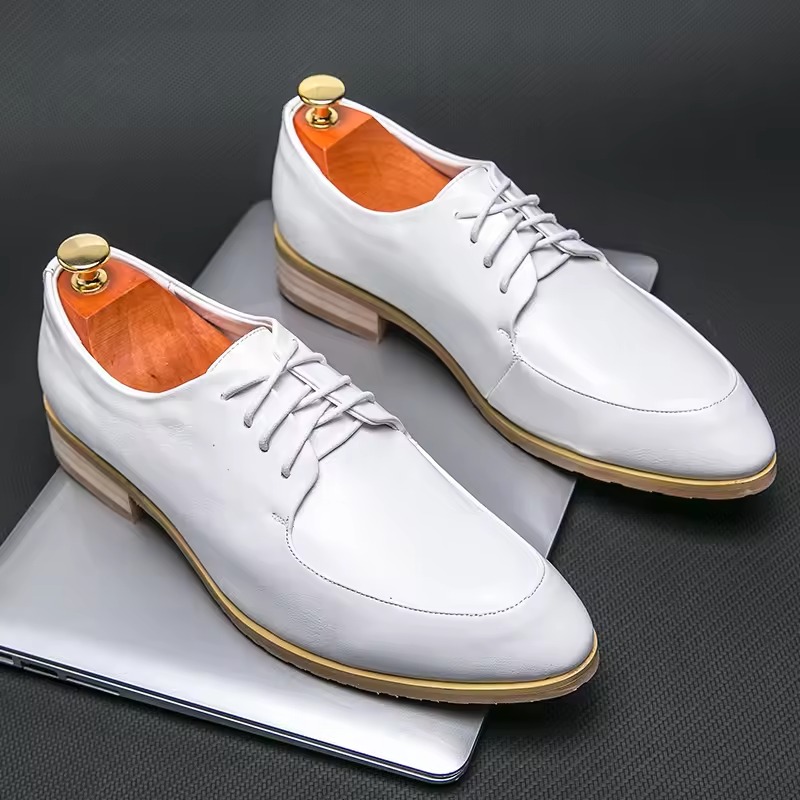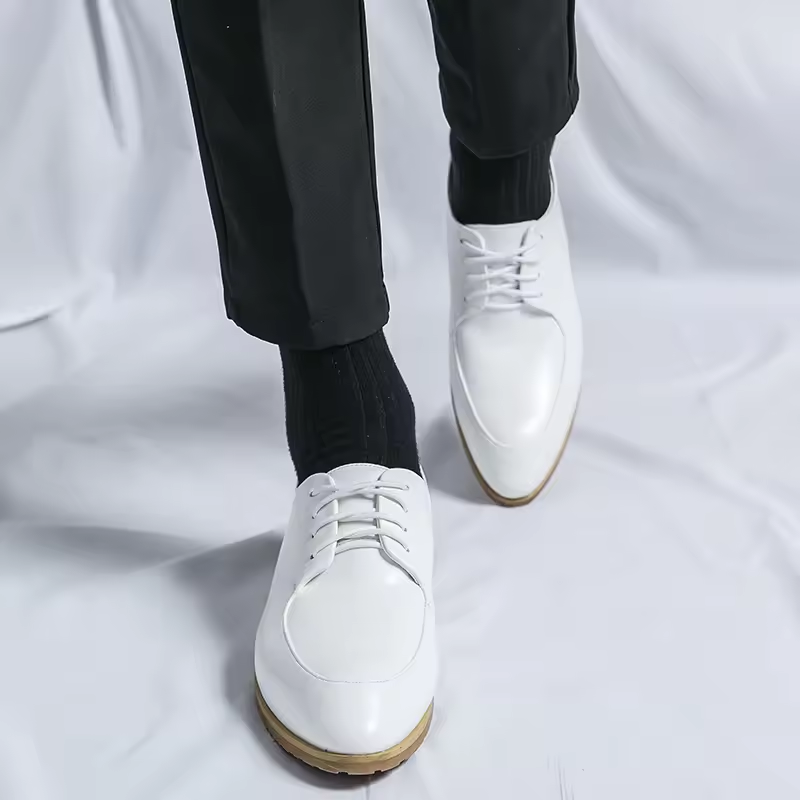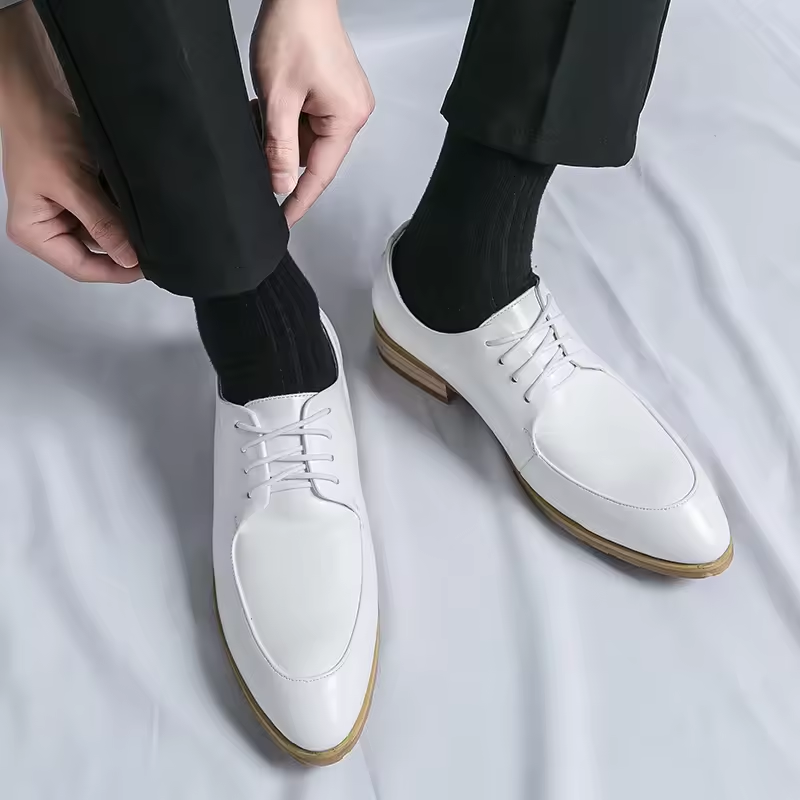Importance of Correct Shoe Sizing
Getting the right shoe size is essential for several reasons. Comfort is the first thing most people think of. A shoe that fits well won’t pinch or rub your feet, preventing blisters and discomfort. But there’s more to proper sizing than just comfort. So, how should dress shoes fit?

When a shoe fits correctly, it supports your feet in the right places. This prevents strain on your ankles, knees, and back. Think about how you feel after a long walk in ill-fitting shoes – typically, you’re not just feeling the pain in your feet but also in other parts of your body. That’s because your body compensates for the lack of support.
A shoe that’s too large can lead to heel slippage, which aside from being annoying, can also cause blisters. On the other hand, a shoe that’s too tight can lead to toe cramps, pain, and long-term issues like bunions or hammertoes. Both scenarios can wreak havoc on your foot health.
Shoe sizing is also critical for maintaining your shoes’ shape and longevity. A shoe that’s too big will crease and wear out quicker from your foot sliding around. A tight shoe, conversely, will stretch and strain the material, also leading to a shorter lifespan.
Lastly, shoe sizing affects posture and walking style. The right size helps maintain proper alignment and balance which is vital for good posture. Remember, the consequences of a bad fit go beyond the feet; they can have a lasting impact on your overall health and comfort. This is why ensuring you have the correct shoe size isn’t a mere detail – it’s a necessity.
Finding the Right Shoe Size
Finding the right shoe size ensures comfort and prevents foot issues. Here’s how to get it right.
- Use a Brannock Device: This tool measures foot length, width, and arch depth accurately. Use one at a store before buying dress shoes.
- Download a Printable Device: If a Brannock Device isn’t available, use a printable version online to measure at home.
- Check Both Feet: Feet often differ in size. Measure both and fit your shoes to the larger foot.
- Consider Foot Changes: Remember, feet can change over time. It’s smart to re-measure before each new shoe purchase.
- Understand Shoe Variance: Different brands and styles fit differently. Always compare the fit of multiple brands and models.
- Note Width Importance: Beyond length, ensure the shoe’s width is right. Wide feet might require special sizing.
By following these steps, you can significantly increase your chances of finding dress shoes that fit perfectly.

The Significance of Shoe Width in Fit
When selecting dress shoes, width is as vital as length. Here are key points about shoe width:
- Recognize Standard Widths: Men’s D and women’s B are standard. Your feet may need a different width.
- Wide Options Are Available: For wider feet, seek wide width shoes. They offer extra space in key areas.
- Check for Tightness: Tight shoes suggest you need a wider size. Don’t ignore snugness.
- Loose Laces Can Indicate Width Issues: If laces are often loose, your shoes may be too narrow.
- Age Affects Width: Feet can widen over time. Consider this when choosing shoe width.
- Width is Crucial for Comfort and Health: Correct width avoids foot problems and ensures comfort.
- Try Wide Width Shoes: Even if you haven’t before, testing a wider shoe might offer better fit.
Follow these tips to ensure your shoes are wide enough for your feet’s comfort and health.
Tips for Trying On Dress Shoes
Trying on dress shoes correctly is key to a comfortable fit. Here are some tips:
- Try Shoes in the Afternoon: Feet swell during the day, so try on shoes later.
- Use the Right Socks: Wear the socks you’d use with the dress shoes for the best fit.
- Stand Up: Always stand when trying shoes to check the space at the toes.
- Check Heel Slippage: A little heel movement is normal, but too much indicates a poor fit.
- Walk Around: Ensure the shoes are comfortable and do not pinch or rub anywhere.
Trying on shoes with these tips in mind will help find the best fit for comfort and style.
Ensuring Proper Toe Fit
When looking for dress shoes, the toe fit is critical for comfort and to prevent foot problems. A poorly fitting toe box can lead to discomfort, calluses, and even deformities like hammertoes over time. Here’s how to ensure a proper toe fit:
- Toe Room: In a well-fitting shoe, there should be about a half-inch of space between your longest toe and the shoe’s front. This space allows your toes room to move without being cramped.
- Toe Box Depth: The top of the toe box should not press down on your toes. This area needs to have enough depth to accommodate your toes comfortably.
- Width Check: Your pinkie toe should not feel squeezed. If the side of your foot feels tight, consider a wider shoe.
- Size Variation: Remember that your feet may not be the same size. Fit your shoes to the larger foot for the best comfort.
By paying attention to these details when trying on dress shoes, you can prevent many common foot issues and ensure a comfortable fit that lasts throughout the day.
Checking Forefoot Fit
Ensuring your dress shoes’ forefoot fits well is essential for comfort and foot health. Here’s how to check for a proper forefoot fit:
- Shake Test: Sit down and tie your shoes. Shake your feet side to side. Shoes should move with your feet, not slide around inside.
- Laces Check: If your shoes feel loose, tighten your laces. If they’re still loose after, a narrower shoe might be needed.
- Walk Test: Stand up and walk. Your forefoot should be snug, not tight. If tight, loosen laces and retry.
- Wide Feet: Wide feet need wider shoes. If you have wide feet, opt for shoes designed with extra room.
- Age Consideration: As you age, feet may widen. Always consider this when testing forefoot fit.
By following these steps, you can prevent issues like blisters and discomfort that come from a bad forefoot fit.
Assessing Heel Fit and Slippage
When checking dress shoes for fit, don’t overlook the heel. Here are some essential tips to ensure proper heel fit and minimize slippage:
- Heel Slippage Test: Walk in the shoes to check for heel slippage. A small amount is normal. If your heel slides too much, the shoes may be too large.
- Finger Test: Place your finger between your heel and the shoe’s back. It should fit snugly, but not too tightly. If your finger slides in easily, consider a smaller size.
- Stiff Soles and Slippage: Dress shoes often have stiff soles. This can cause minor heel movement. Excessive movement, however, might lead to blisters or indicate a poor fit.
- Heel Grip: The shoes should grip your heel snugly without causing discomfort. A good grip helps prevent your foot from slipping out.
- Check for Gaps: Stand in your shoes and feel for gaps around the heel area. Your shoes should fit closely without pinching.
By paying attention to these factors, you can find shoes that fit well and avoid common heel issues.

Understanding Leather Stretch and Shoe Break-In
When buying dress shoes, remember that leather can stretch. Here’s how this affects fit:
- Leather Stretch: New leather shoes fit tightly. With wear, they will stretch and mold to your feet.
- Break-In Period: Expect a break-in period for leather shoes. Initially, shoes may feel snug.
- Right Initial Fit: Choose shoes that are comfortable from the start. They shouldn’t pinch or hurt.
- Natural Stretch, Not Forced: Let leather stretch naturally. Don’t use tools or heat to stretch them.
- Comfort During Break-In: Wear thicker socks at first if needed. This helps stretch the shoes.
- Monitor Fit Over Time: As shoes break in, check their fit again. Adjust laces as needed for comfort.
Following these guidelines will help ensure your leather dress shoes fit well over time.
Measuring Feet at Home vs. The Brannock Device?
When buying dress shoes, accurate foot measurement is crucial. Here’s a comparison of two common methods:
- Brannock Device: This metal tool measures length, width, and arch depth. Find it in most shoe stores.
- Home Measurement: Use paper and a ruler if you can’t access a Brannock Device. It’s less accurate but can work.
Both methods aim to find the perfect shoe fit for comfort and support. Let’s explore the pros and cons of each method:
Brannock Device Advantages
- Precise Measurements: It gives detailed info on foot size.
- Professional Use: Experts often use this for the best fit.
- Considerate of Arches: It includes arch length, which is important.
Brannock Device Disadvantages
- Not Always Accessible: Not everyone can visit a store.
- Can Be Intimidating: Some may find the device complex.
Home Measurement Advantages
- Convenience: Measure anytime at home.
- Easy to Do: Just a pen, paper, and ruler needed.
Home Measurement Disadvantages
- Less Detail: Doesn’t include arch measurement.
- Variability: Different ways to measure can give varied results.
No matter the method, remember to measure both feet. Fit shoes to the larger foot for the best comfort. Measure feet more than once. Feet change size over time or throughout the day. Doing this helps keep dress shoes comfortable and avoids foot pain.
Why One Size Doesn’t Fit All: Brands and Sizing Differences
Not all dress shoes fit the same across different brands. This variation often surprises shoppers. Here’s why one size doesn’t fit all:
- Brand Specific Sizing: Each brand may use unique measurement standards. What’s a size 9 in one brand could differ in another.
- Model Differences: Even within a brand, models can fit differently. Always try before you buy.
- Country of Origin: Sizing often varies by country. European sizes are not the same as US sizes.
- Material and Design: The materials and shoe design can affect fit. Leather might stretch; synthetic materials generally won’t.
Understanding these differences is vital. It helps you find shoes that fit well and feel good. Always compare fits and remember that the best size for you might change with different brands.
The Role of Socks in Shoe Fitting
When trying on dress shoes, socks play a key role in finding the correct fit. Here’s how they influence shoe fitting:
- Match Sock Thickness: Wear the type of socks you plan to use with the shoes. The thickness of socks can change the fit.
- Consistent Sock Use: Always try on shoes with the same socks for consistency. This prevents surprises in fit later on.
- Socks Affect Comfort: Thick socks can add cushioning but also make shoes tighter. Choose wisely based on comfort needs.
- Material Matters: Sock material impacts fit and foot health. Cotton breathes well, while synthetics may not.
Always consider the role of socks when fitting dress shoes to ensure a snug, yet comfortable, fit.
DIY Adjustments for a Better Shoe Fit
To improve the comfort and fit of your dress shoes, consider these DIY adjustments:
- Use Tongue Pads: Add pads to tighten the fit if your shoes feel loose around the tongue.
- Insert Heel Grips: Stick heel grips inside the back of the shoes to stop slippage and avoid blisters.
- Place Insoles: For added comfort or if shoes are too big, use insoles. They offer extra cushioning and can make a big difference.
- Try Different Lacing Techniques: Use lacing methods to help with tight spots or to secure a loose fit.
- Install Arch Supports: If you have flat feet or high arches, arch supports can enhance shoe fit and comfort.
- Trim Toes Area of Inserts: If the toe box is tight, trim the front part of inserts. This will give your toes more room.
By applying these simple changes, you can tailor your dress shoes for a more personal and improved fit.
The Impact of Ill-Fitting Shoes on Foot and Shoe Health
Wearing the wrong shoe size can lead to various foot problems. Shoes that don’t fit can cause discomfort, blisters, and even long-term issues like bunions. Poor fitting shoes can strain ankles, knees, and back, leading to broader health concerns. Heel slippage in large shoes can cause blisters, while tight shoes may cramp toes and lead to deformities.
Ill-fitting shoes not only harm your feet but also damage the shoes themselves. Shoes that are too large will crease more and wear out faster. Tight shoes strain the material, reducing their lifespan. Both situations call for replacements sooner than if shoes fit well, meaning more expense for you.
Correct fitting affects your walking style and posture. It helps maintain your body’s proper alignment and balance. Incorrect shoe sizes can lead to a bad posture and discomfort. This underlines the need for a good fit, not just for your feet’s comfort but also for your overall well-being.
In summary, the importance of wearing well-fitting dress shoes extends beyond comfort. Ill-fitting shoes can impact foot health and shoe longevity. They influence your walking style, posture, and can lead to a chain reaction of bodily pains. Invest time in finding the right fit to prevent these issues and protect your health and your footwear investment.